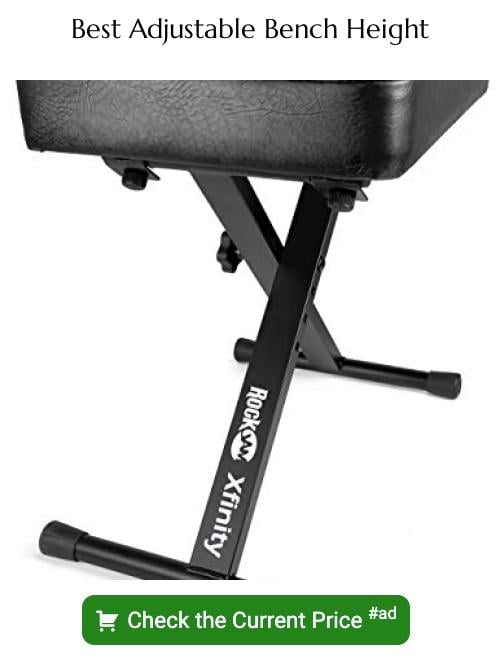Last updated on
Decoding the intricacies of bench height is crucial because it significantly impacts ergonomics, versatility, productivity, as well as the possibilities of adjustability and customization.
Discovering the ideal bench height is more than a matter of aesthetics; it’s key to your comfort and health. Whether you’re toiling at an office desk, prepping dinner, or sitting down to dine, the height of your bench is pivotal to avoiding unnecessary strain on your body and boosting your overall productivity.
Balancing ergonomics with functionality, adjustable benches have emerged as a versatile solution, catering to an array of activities and body types. In the quest for the perfect setup, understanding standard height guidelines and the benefits of customizability can transform your work or living space into an environment that supports your well-being.
This article delves into the world of bench heights, offering insights and recommendations to help you achieve peak performance and comfort in every aspect of your daily routine.
Key takeaways:
- Proper bench height reduces strain on shoulders, back, and arms.
- Adjustable benches promote better posture and enhance productivity.
- Different tasks require different bench heights for optimal performance.
- Standard bench height recommendations for office work, kitchen counters, and dining settings.
- Adjustable benches provide customization and adaptability for diverse users.
Why Is Bench Height Important?

Selecting the appropriate bench height is crucial for several reasons that impact both comfort and health. Ergonomically, a bench that aligns with the user’s elbow height minimizes strain on the shoulders, back, and arms, reducing the risk of musculoskeletal issues. This alignment is particularly important for tasks that require precision or force, such as woodworking or cooking.
A bench that is too high or too low can lead to awkward postures, which over time can cause discomfort and injury.
In addition to health benefits, the right bench height can also enhance productivity. When individuals are comfortable and their work surface is at the correct height, they can perform tasks more efficiently and with greater ease. This can lead to improved focus and reduced fatigue, allowing for longer periods of productive activity.
Therefore, considering bench height is not just about fitting the furniture to a space but also about fitting the furniture to the user’s needs for a harmonious and functional environment.
Ergonomics

Selecting the correct bench height is crucial for maintaining good posture and preventing strain. A bench that aligns with your elbow height while seated allows your arms to rest comfortably, reducing shoulder and back tension.
When you find the optimal position, your feet should be flat on the ground with your knees at a 90-degree angle, ensuring your thigh and calf form a straight line to the floor, which helps avoid leg fatigue. Adequate under-bench clearance is also important to accommodate your legs and allow for easy movement.
Keep in mind that working for extended periods requires periodic changes in posture; therefore, an adjustable bench can be a significant ergonomic advantage, allowing you to alternate between sitting and standing positions.
Productivity
Selecting the proper bench height enhances comfort, which can lead to an increase in productivity. An ergonomically aligned workspace minimizes the need for frequent breaks due to discomfort, allowing for more uninterrupted work time.
Here are several ways in which this can be beneficial:
- Reduced Fatigue: Correct bench height keeps the body in a neutral position, reducing muscle strain and fatigue.
- Increased Concentration: With less physical distraction from discomfort, focus on tasks tends to improve.
- Quicker Task Completion: An ergonomic setup can streamline workflows, making repetitive motions more efficient and reducing the time it takes to complete tasks.
- Lower Risk of Injury: Proper height helps prevent repetitive strain injuries, which in turn reduces absenteeism.
- Enhanced Quality of Work: Comfortable working conditions can lead to improved precision in tasks that require fine motor skills.
Ensuring your bench height aligns with your ergonomic needs can be a simple yet effective way to bolster work performance.
How to Determine the Ideal Bench Height
To identify the perfect height for your bench, first stand up straight and bend your elbows at a 90-degree angle, as if you were performing the task you’ll be doing at the bench. Measure the distance from the floor to the bottom of your elbow – this is your ideal bench height for tasks that require precision and arm support, such as woodworking or typing.
However, the type of activity greatly influences the ideal height. For activities that involve more force or bigger movements, like hammering or chopping, a lower bench height may be beneficial to leverage your body weight.
Also consider that when seated, your feet should rest flat on the floor with your thighs parallel to the ground, thus ensuring comfort and reducing the risk of strain.
For workbenches used in a standing position, ensure the surface height aligns with your hip or waist when standing straight. This reduces the need to stoop or reach excessively, minimizing discomfort and potential injury.
While these guidelines provide a starting point, factors such as individual body proportions and unique task requirements might necessitate adjustments. An adjustable bench offers the flexibility to cater to these variations, promoting better posture and comfort for a diverse range of users and uses.
Measure Your Elbow Height
Determining the right bench height starts with a personal measure: your elbow height. To get this, stand in an upright position, place your arms at your sides, then bend your elbows at a 90-degree angle. Have someone measure the distance from the floor to the bottom of your elbow. This figure represents the most ergonomic height for a work surface or bench.
For precision tasks that require more attention, the bench should match your elbow height or be slightly higher.
When heavy labor is involved, opt for a bench slightly below elbow height to leverage full body strength.
If you’ll be seated while working, measure your seated elbow height and consider the type of chair or stool you use.
Remember, the goal is to prevent strain on your shoulders, back, and arms during repetitive tasks. Proper height helps maintain a neutral posture, minimizing the risk of musculoskeletal issues.
Consider the Type of Work
The tasks you perform largely dictate the height of your work surface. Precision work, like electronics assembly or watchmaking, typically requires a higher bench to bring the task closer to eye level and reduce strain on your shoulders. Conversely, heavy-duty tasks such as hammering or chopping benefit from a lower surface, granting more leverage and control.
Crafting or writing, activities that involve a mix of fine motor skills and comfort, usually call for a bench height that aligns with your seated elbow height to minimize wrist pressure and maintain a natural posture. Remember, proper alignment is key to preventing discomfort and possible injury over time.
Benefits of Adjustable Benches
Adjustable benches offer the flexibility to tailor the height to individual needs, promoting a better posture that aligns with ergonomic principles. They enable users to switch between tasks with varying requirements, such as precision work that may necessitate a higher surface or heavier work that is better performed at a lower height.
This versatility enhances comfort during prolonged periods of sitting or standing, which can lead to increased focus and efficiency. These benches also cater to the needs of multiple users in shared spaces, ensuring that each person can work at their optimal bench height, reducing the risk of strain and injury.
The ability to adjust height encourages users to alter their position throughout the day, which is beneficial for circulation and muscle engagement.
Customization
Adjustable benches are a game-changer in both personal and professional spaces, allowing users to alter the height to suit individual needs. Here’s why customization is key:
- Tailored Comfort: By tweaking the bench height, users find a perfect fit, which is especially beneficial for prolonged sitting or standing tasks.
- Shared Spaces: In environments where different people use the same bench, adjustability ensures everyone can work comfortably.
- Evolving Needs: As tasks change, so can the bench height, accommodating everything from detailed handiwork to heavy lifting.
- Posture and Health: Correct bench height promotes better posture, reducing the risk of repetitive strain injuries and enhancing overall well-being.
Select a bench that offers easy-to-use adjustment mechanisms for a smooth transition between heights.
Adaptability
Adjustable benches allow for a level of flexibility that fixed benches can’t match. They cater to the needs of multiple users, each with unique body dimensions and preferences. This adaptability is essential in collaborative and dynamic environments, such as shared workspaces and educational settings, where a range of activities might occur.
The ability to modify bench height on the fly is particularly beneficial for tasks that require different postures, from precision work that is best done at a higher level to more forceful tasks that may necessitate a lower surface. Additionally, these benches make it easier for individuals who may have specific ergonomic requirements due to physical challenges or disabilities, ensuring comfort and accessibility for all users.
Standard Bench Height Recommendations
When setting up workspaces and dining areas, adhering to the recommended bench heights ensures comfort and efficiency. For office or computer work, a bench height that aligns with the user’s seated elbow height is ideal, typically around 28 to 30 inches, to maintain a neutral arm position and minimize strain. For kitchen counters used for food preparation, the standard is slightly higher, around 36 inches, allowing tasks to be completed without excessive bending or reaching.
In dining settings, the average bench height is approximately 18 inches, a suitable position for most adults to sit comfortably with their feet flat on the floor and their thighs parallel to the ground. This height maintains proper posture and supports easy movement from sitting to standing.
For specialized workbenches, such as those in garages or workshops, heights may vary. They are often set taller, around 38 to 42 inches, to accommodate standing work that requires leverage and more forceful handling of tools and materials.
Remembering these guidelines helps create spaces that are both functional and welcoming, enhancing daily experiences whether one is hard at work or enjoying a meal with family and friends.
FAQ
What is the standard height for a bench?
The standard height for a bench typically ranges between 18 and 20 inches.
How high should a bench be above ground?
A bench should be positioned 17 to 19 inches above the ground.
How tall is a mudroom bench?
A mudroom bench is typically around 16 to 18 inches tall for comfortable shoe removal and storage accommodation.
What is the recommended height for a kitchen bench?
The recommended height for a kitchen bench is typically between 34 to 38 inches.
How does bench height affect posture and comfort?
Bench height significantly impacts posture and comfort as an incorrectly positioned bench can cause strain on the back, neck, and shoulders leading to discomfort and potential long-term health issues.
Are there regulations governing the height of public benches?
Yes, regulations concerning public bench heights exist, dictated by local government rules and regulations, often stipulating that they range between 17 and 19 inches in height.
Recap:





